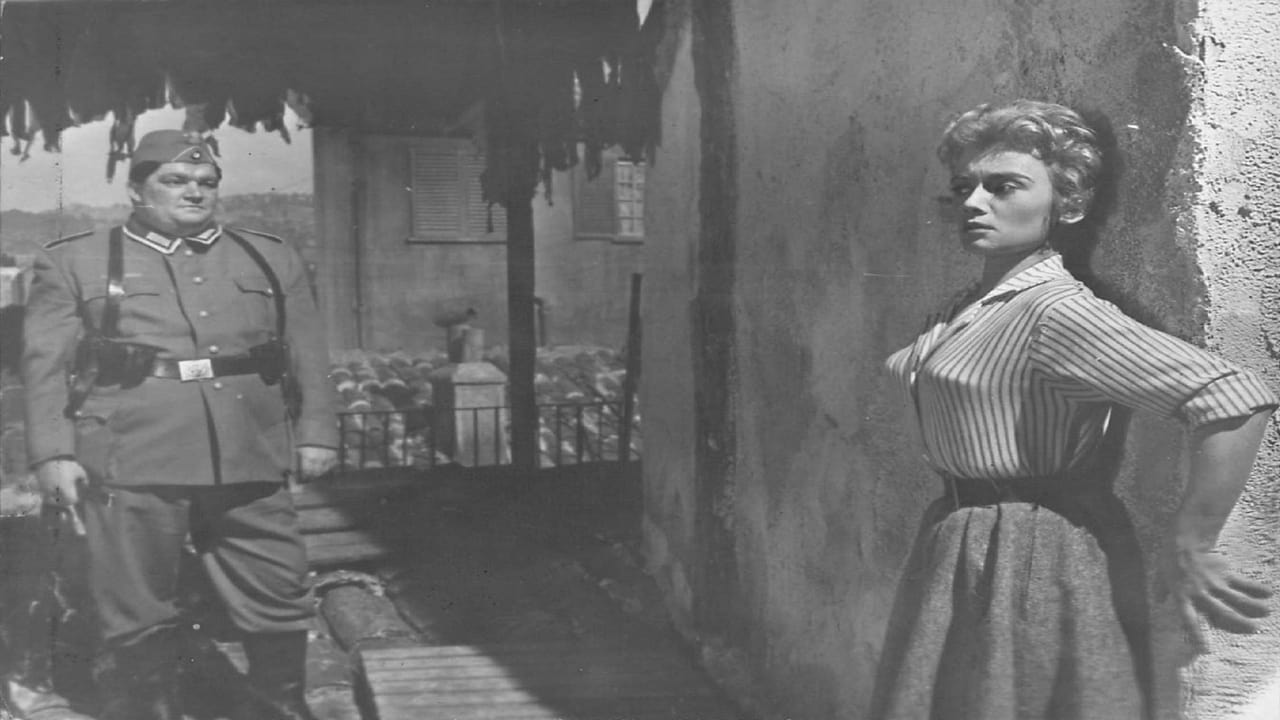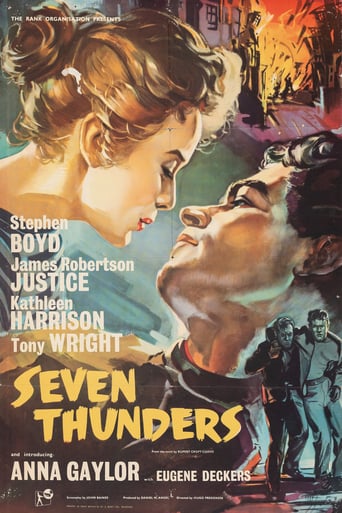

This is a remarkable film based upon the horrific true events of January 1943 when the Nazis and their lapdogs the Vichy French dynamited and destroyed the entire First Arondissement of Marseilles, the area known as the Old Port of Marseilles. A great deal of real documentary footage of the buildings being blown up is incorporated into this dramatic film, so the result is terrifyingly convincing, and it reminds us of what is happening today in some of the cities of Syria. The 'seven thunders' of the original film title SEVEN THUNDERS presumably refer to the explosions, though the phrase does not occur in the film dialogue, and the title is never overtly explained on screen. This film has now been released on DVD under its original title and is no longer called THE BEASTS OF MARSEILLES. The story is based upon a novel by Rupert Croft-Cooke (1903-1979). He was a gay man who used to hang out at the Fitzroy Tavern in London's Fitzrovia, where Nina Hamnett and the other artistic and literary Bohemians were often be found in the 1950s, along with Tambimuttu and those two well-known gays, Sir John Waldron and Sir Francis Rose (my wife and I knew the last-named three but never met Hamnett or, knowingly, Croft-Cooke; Francis was Gertrude Stein's 'Rose is a Rose is a Rose', by the way, though it is surprising how few people seem to know that, imagining that she was speaking of a flower). The lead female role in this film is played by the French actress Anna Gaylor. She is by far the best thing in the film, as her charming, cheeky gamine persona lights up the screen. And that took some doing, because Stephen Boyd as the male lead is rather dull and uninspired beside her. At this time Gaylor was 25 and is still with us today, aged 79, having appeared in 121 films, and this one was only her third feature film, as her career only started the year before, in 1956. This film must have boosted her career a lot, as she is so cute she is really irresistible. Even Stephen Boyd cannot resist her, and for a block of wood, that says something. There is a weird sub-plot to this story, in which a psychotic murderer pretends to help Jews and others escape the Vichy police. He is played by James Robertson Justice with a creepy urbanity. It is his habit to offer a glass of drugged cognac to fugitives. Then they fall asleep, he takes their money, and carries them to the basement where he dissolves their bodies in quicklime. Quick lime, quick fortune. He lives in a very well-furnished house indeed, full of valuable antiquities earned from his ghastly career. He is keen to murder his 100th victim. Will he live long enough to reach his target number? He reminds me of the quiet murderer portrayed by Jules Romains in his MEN OF GOOD WILL series of novels. Such people always send a chill up one's spine, or down one's spine, depending upon temperament and whether one is standing on one's head or not. I suppose that some yogis in that position have descending rather than ascending kundalini, but Pātanjāli does not discuss that technicality. There is an odd feature to this film, however, and I must call attention to it. All the 'bad guys' who destroy the Old Port are shown as Germans in uniform. But the truth is entirely different. Try typing 'Battle of Marseille' into Google and go to that entry in Wikipedia, and you will see what I mean. (They leave the 's' off Marseilles, not sure why.) What really happened is that this was all done by the Vichy French police, who were more eager to kill Jews than the Gestapo themselves, and who grovelled on their bellies to the Nazis like the slimy worms they were. Their motto seems to have been: 'Whom can we kill for you today, can't you think of someone? Heil Hitler! Let me lick your jackboots!' Why was all of this omitted from the film and German soldiers substituted instead? The entire idea was carried out by the revolting traitor, René Bousquet, who was such a close chum of Francois Mitterand that he used to visit him for chats about the good old days after Mitterand became President of France. Mitterand, who posed as a socialist to gain power, had been a keen Vichy official working for the Nazis. No hypocrisy there, surely! 120 French police inspectors travelled from Paris to supervise the work and altogether 12,000 French police implemented the plan. 30,000 French people were forcibly evacuated from their homes, 2,000 arrested and send to the death camps, and 1,500 buildings were blown up in a single day, most of them containing the possessions of the ousted inhabitants. And all this was done by the French, willingly and enthusiastically, not by the Nazis themselves. The depths of evil, treachery, and betrayal against their fellow countrymen by the Vichy authorities laid the basis for the fantastic immorality and corruption of modern French business and politics. The French people know this, and that is why the French thrillers such as TELL NO ONE (2006, see my review) always have a corrupt politician or sinister state plot in the background. The fact is that the French people do not trust those in authority over them and have not done so since Vichy, and with good reason. After all, when you end up with a supposedly left-wing President who was really a Vichy traitor, and when you narrowly avoid having the appalling and now disgraced Strauss-Kahn as President, not to mention the most snobbish man in France, Giscard d'Estaing, also as a past President, what hope is there? But why were the Vichy French crimes suppressed in this film? That is a very good question.
... View MoreThis sick themed war drama has a psychotic doctor exploiting the situation with Nazis by killing refugee wannabees and potential prisoners of war by having them convert all their money into gold with the promise of getting them out of France. James Robertson Justice (the sweets factory owner from "Chitty Chitty Bang Bang") is the nasty "Beast of Marseilles" who tells one Jewish undertaker desperate to meet his family over in England that he is saving him from the tortures of a concentration camp. While all of this is going on, the Nazis introduce much terror to the residents, including a lecherous fat soldier who after twice trying to rape the young heroine ends up having a date with the concrete below when he falls off a roof after having a fight with her lover.Generally unpleasant and slow-moving, this seems an odd story to be telling more than a decade after the end of the war. Stephen Boyd is the young hero fighting both the Germans and the evil Justice who enjoys his murderous ways as a painter would be uncovering his new artwork. This is an "A" version of the type of film that Tod Slaughter would have menaced in a decade before. The only thing that is of interest in this really is the manner in which the villain is exposed and ultimately dealt with.
... View MoreWhat a pleasant find this movie was in a 10-movie set, called British War Cinema. It's not a combat film, nor an espionage or resistance film. At its core, it's a film about the hiding and freeing of two escaped British soldiers who wind up in Marseilles in 1943. Around that core story are four or five more stories, and the writers and director weave these nicely into a taught film with intrigue, betrayal, evil and romance. I won't divulge the plot here, but say that it includes French underground people and others who risk their lives to help people fleeing the Nazis. It also shows the dark side of those who took advantage of the plight of war. The romance is one of the more believable ones I've seen in war movies. And, this film shows something of the life in the seedy area of the Old Port, under Nazi control. The directing, acting, cinematography and music are all excellent. The destruction of the Old Port is shown with very good film footage from some source. I'm not aware of any other film that covered this war-time incident. The movie is based on a novel by Rupert Croft-Cooke. I didn't read the book and don't know if it's still available anywhere. So, I don't know how much the movie follows the book. But, based on the incidents in the film, the movie comes very close to some things that actually happened during that time. It thus has some historical value as well.The film opens in the Old Port area of Marseilles in 1943. The so-called Battle of Marseilles, or Marseilles Roundup in the Old Port took place on January 22 – 24, 1943. It was under the Vichy government at the time, and more than 12,000 French police were involved with the Nazis. We see very few policemen in this film – could it be because of sensitivities in 1957 when this movie came out? Surely, there would have been many thousands of people living in France then who had collaborated with Nazi Germany but were never prosecuted for it. Anyway, the roundup that took place was to arrest Jews. It resulted in more than 2,000 people being sent to death camps. The Old Port neighborhood was also considered a terrorist nest and seedy area, as depicted in the film. So, after the roundup, the authorities razed the entire Old Port, displacing some 30,000 people. The author and/or screenwriters added the character of Dr. Martout to the events in Marseilles, based on a real-life person who "operated" in and near Paris before and during the war. Dr. Marcel Petiot (1897- 1946), known as the "Butcher of Paris," was executed in 1946 for the killing of 26 people. He was suspected to have murdered more than 60 people. He supposedly had an escape underground operation for those fleeing the Nazis. In reality, it ended in the death of those who put their trust in him, as shown in the film. "Seven Thunders," had a more apt title, I think, with its first release in England – "The Beasts of Marseilles." I highly recommend this film for any war film aficionados and for any historical film library.
... View MoreA gripping, unusual study of the people of the port of Marseilles during Nazi occupation...the supporting characters are outstanding: James Robertson Justice as a secret murderer posing as a benevolent arranger for people desperate to escape, his several victims as he works to achieve an even 100, the plucky jeune femme who does her best to "capture" the English POW (Boyd), and each person right down to the German troopers (the overweight beastly molester, and the callow and nervous trigger-happy 20 yr. who kills a child.) Every performance in this film is meticulous and authentic, and helps in building to a very tense and suspenseful outcome. And there are moments of great pathos and excitement along the way. Don't miss this one, it's a neglected gem.
... View More